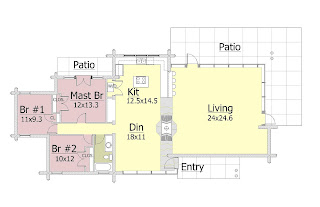Rainwater properties are the purest state in the hydrologic cycle, but atmospheric pollution in some areas can affect water quality.
To harvest high quality water all parts of a rainwater collection and storage system need to be considered. There are two types of systems, one where roof captured rainwater runs downhill by gravity to the cistern and is distributed, the second is where diverted water runs by gravity to a mechanical pump tank where the water is drawn to a cistern and used.
All roof components should be non-toxic and non-leaching. This is important because oxidizing affects on metal roofs occur due to atmospheric conditions and air pollution which can change water quality. If an existing roof has lead flashing at sky lights and plumbing vents that prenetrate the roof, replace them. The best type of roofing material is a smooth galvanized metal roof that has been factory painted (enameled) with a non-toxic material. Asphalt shingles will work but are difficult to keep clean and free of mold. Beware of mold resistant chemicals on roof shingles that can leach into the water supply.
Gutters and downspouts should be enameled and galvanized or made of aluminum. Vinyl is also a good non-toxic material for components. Slope the gutter along the eave so water can run downhill with no areas of standing water where microbes can thrive. Hidden Gutters and Gutter Guards are easy to clean but are affected by the amount of trees around them. Be careful with any vines or trees with toxic berries or leaves from falling on the gutter system.
Near the ground when the downspout transitions to a PVC standing pipe, paint the PVC pipe (to match house color) with a paint that incorporates UV protection. Also, downspouts are good places to include leaf and debris traps that begin the purifing process.
If the rainwater is used for potable water its important to use a sediment mesh screen filter to clean the water before it enters the cistern. A flush diverter is another component of the system that helps you acquire quality water. When it begins to rain water picks up dirt and undesirable deposits from the roof. The flush divertor redirects a small percentage of leading water flow to a separate tank that flushes the contaminated water to a buried first flush diverter pipe.
If the system has non-gravity water flow a water/surge pump is required to push the rainwater to the collection tank. The size of the pump and the storage tank can vary from 100 gallons to as much as 1,000 gallons depending on required water usage. Common storage tanks are made of molded polyetheylene and can be above ground or buried to offer UV protection. Sunlight can deteriorate the tanks’ material affecting the quality of captured rain water. If rainwater is to be used for interior house purposes a distribution and sanitation system is required with particle filtration and UV light disinffection.
The last and best component that assures quality water is a long term cleaning and maintenance schedule to keep the system operational. Wheather you do it yourself or hire a maintenance company, keeping the system checked and in good working condition is crucial.












